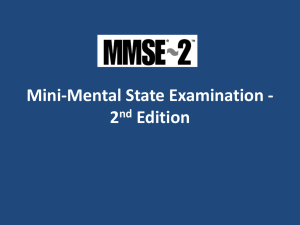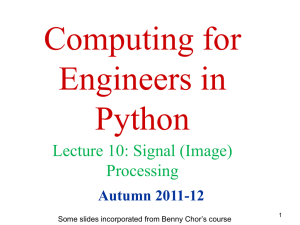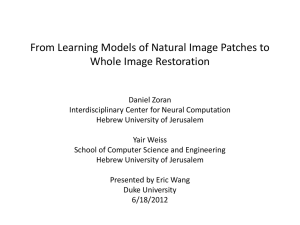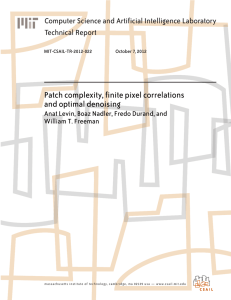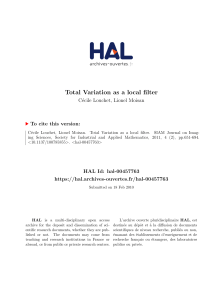PatchComplexityLevin..
advertisement
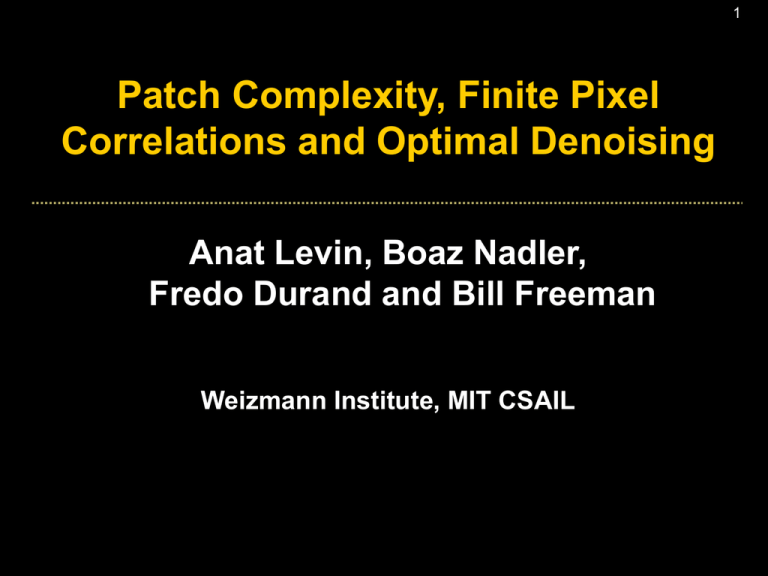
1 Patch Complexity, Finite Pixel Correlations and Optimal Denoising Anat Levin, Boaz Nadler, Fredo Durand and Bill Freeman Weizmann Institute, MIT CSAIL Image denoising Many research efforts invested, and results harder and harder to improve: reaching saturation? • What uncertainty is inherent in the problem? • How further can we improve results? 2 Denoising Uncertainty What is the volume of all clean x images that can explain a noisy image y? y 3 Denoising Uncertainty What is the volume of all clean images x that can explain a noisy image y? Multiple clean images within noise level. y 4 Denoising limits- prior work • Signal processing assumptions (Wiener filter, Gaussian priors) • Limits on super resolution- numerical arguments, no prior [Baker&Kanade 02] • Sharp bounds for perfectly piecewise constant images [Korostelev&Tsybakov 93, Polzehl&Spokoiny 03] • Non-local means- asymptotically optimal for infinitely large images. No analysis of finite size images. [Buades,Coll&Morel. 05] • Natural image denoising limits, but many assumptions which may not hold in practice and affect conclusions. [Chatterjee and Milanfar 10] 5 MMSE denoising bounds MMSE p( y ) Vx| y p( y ) p( x | y )( xc ( y )) 2 dxdy MMSE= conditional variance, achieved by the conditional mean MMSE with the exact p(x) (and not with heuristics used in practice), is the optimal possible denoising. By definition. Using internal image statistics or class specific information might provide practical benefits, but cannot perform better than the MMSE. By definition! 6 7 MMSE with a finite support MMSE dd p( ywd ) Vxwd | ywd p( ywd ) p( xwd | ywd )( xc d ( y )) dxdy 2 MMSEdd best possible result of any algorithm which can utilize a d=k x k window wd around a pixel of interest e.g. spatial kernel size in bilateral filter, patch size in non-parametric methods Non Local Means: effective support = entire image Estimating denoising bounds in practice MMSE p( y ) p( x | y )( xc ( y )) 2 dxdy Challenge: Compute MMSE without knowing p(x)? The trick [Levin&Nadler CVPR11]: We don’t know p(x) but we can sample from it Evaluate MMSE non parametrically Sample mean: p( y | x ) x ˆ ( y ) p( y | x ) 1 N 1 N i i i xi ~ p( x) i ,c i xi 8 MMSE as a function of patch size 35 patch size [Levin&Nadler CVPR11]: For small patches/ large noise, non parametric approach can accurately estimate the MMSE. 9 MMSE as a function of patch size 35 patch size How much better can we do by increasing window size? 10 Towards denoising bounds Questions: • For non-parametric methods: How does the difficulty in finding nearest neighbors relates to the potential gain, and how can we make a better usage of a given database size? • For any possible method: Computational issues aside, what is the optimal possible restoration? Can we achieve zero error? 11 Patch Complexity ? 12 Patch Complexity ? 13 Patch Complexity ? Empty neighbors set 14 Patch Complexity ? 15 Patch complexity v.s. PSNR gain Law of diminishing return: When an increase in patch width requires many more training samples, the performance gain is smaller. Smooth regions: Easy to increase support, large gain Textured regions: Hard to increase support, small gain Adaptive patch size selection in denoising algorithms. See paper 16 Pixel Correlation and PSNR gain y1 17 Pixel Correlation and PSNR gain Independent y1 y2 Fully dependent y1 y2 18 Pixel Correlation and PSNR gain Independent Few neighbors No gain from y2 19 Fully dependent Many neighbors When the samples are correlated, going y2 => factor 2 variance reduction from 1D to 2D does not spread the samples. Towards denoising bounds Questions: • For non-parametric methods: How does the difficulty in finding nearest neighbors relates to the potential gain, and how can we make a better usage of a given database size? • For any possible method: Computational issues aside, what is the optimal possible restoration? Can we achieve zero error? - What is the convergence rate as a function of patch size? 20 The Dead Leaves model (Matheron 68) Image = random collection of finite size piece-wise constant regions Region intensity = random variable with uniform distribution 21 22 Optimal denoising in the Dead Leaves model Given a segmentation oracle, best possible denoising is to average all observations within a segment Expected reconstruction error: 2 s s=number of pixels in segment MMSE 1 2 s p ( s )ds Optimal patch denoising & Dead Leaves d MMSE d 1 2 s p ( s )ds d Segment area <d 23 2 dd p ( s )ds Segment area >d p(s) Probability of a random pixel belonging to a segment of size s pixels What is p(s)? For a given window size d: - If segment has size s smaller than d, only average over s pixels - Otherwise, use all d pixels inside window (but not the full segment) Scale invariance in natural images Down-scaling natural images does not change statistical properties [Ruderman, Field, etc.] Theorem: in a scale invariant distribution, the segment size distribution must satisfy 1 p( s) s Empirical segment size distribution: (Repeated from Alvarez, Gousseau, and Morel.) Fit 24 25 Optimal patch denoising & scale invariance d MMSE d 1 1 1 p( s)ds p( s)ds s s d s d 2 Segment area <d 2 Segment area >d c MMSE d Empirical PSNR v.s. window size 100 PSNR PSNR 50 Window size Good fit with a power law c MMSE d e d Window size Poor fit with an exponential curve (implied by Markov models) MMSE d e cr d 26 Extrapolating optimal PSNR MMSE d MMSE c d Future sophisticated denoising algorithms appear to have modest room for improvement: ~ 0.6-1.2dB 27 28 Summary: inherent uncertainty of denoising Non-parametric methods: Law of diminishing return - When increasing patch size requires a significant increase in training data, the gain is low - Correlation with new pixels makes it easier to find samples AND makes them more useful - Adaptive denoising For any method: Optimal denoising as a function of window size follows a power law convergence - Scale invariance, dead leaves - Extrapolation predicts denoising bounds MMSE Scope: Limitations: - MSE - Our database - Power law extrapolation is a conjecture for real images MMSE is by definition the lowest possible MSE of any algorithm Including: object recognition, depth estimation, multiple images of the same scene, internal image statistics, each. 29


